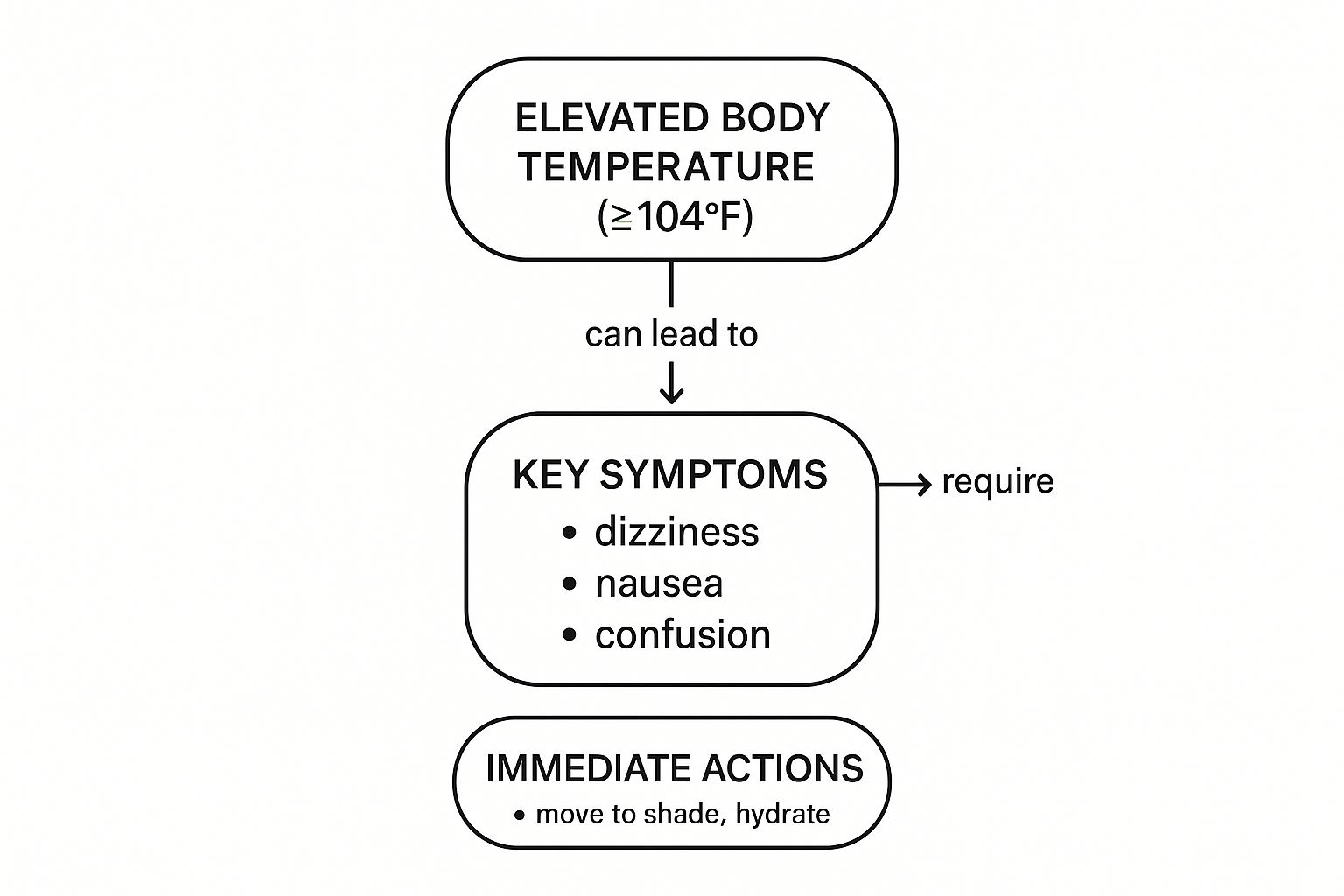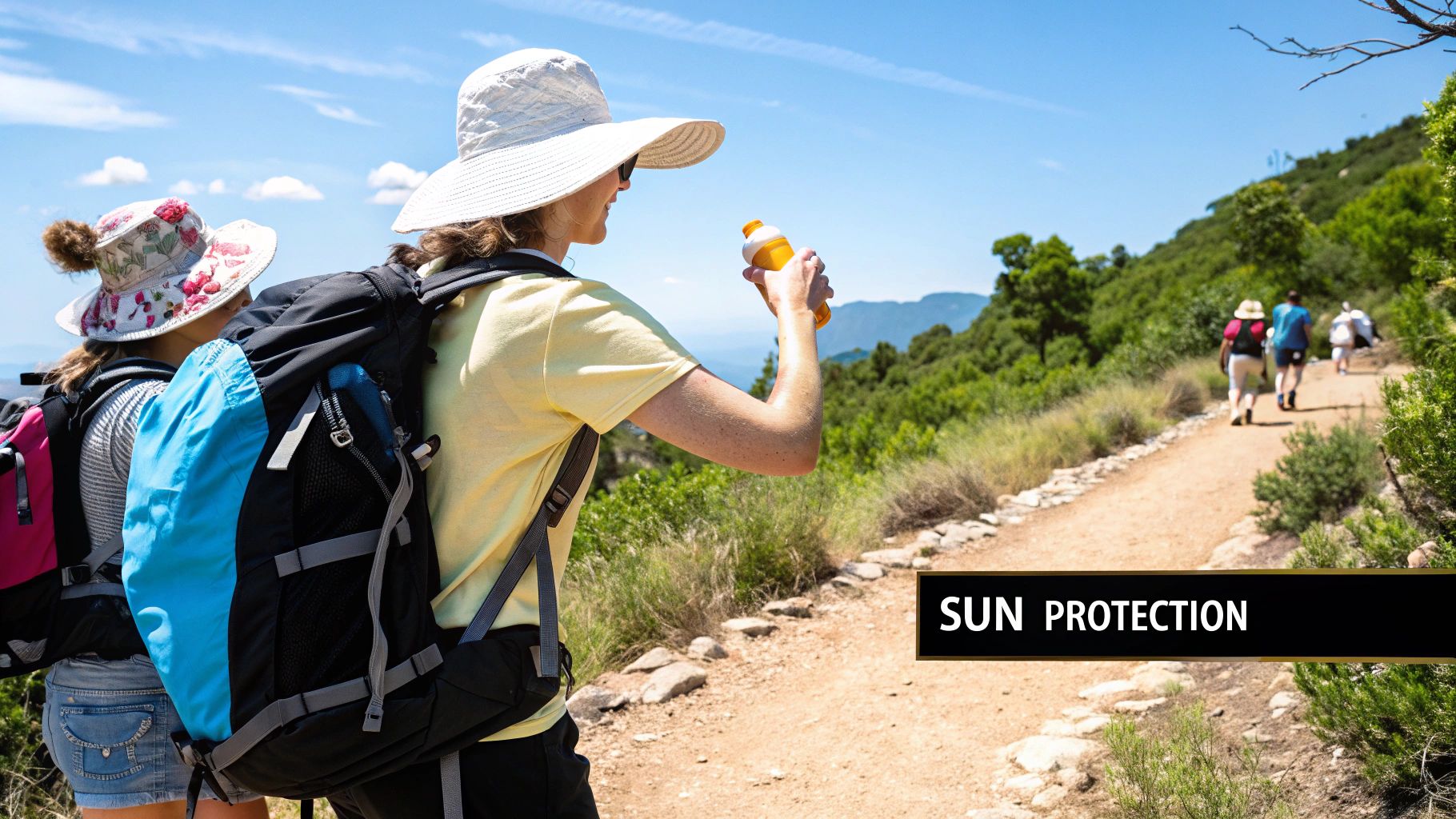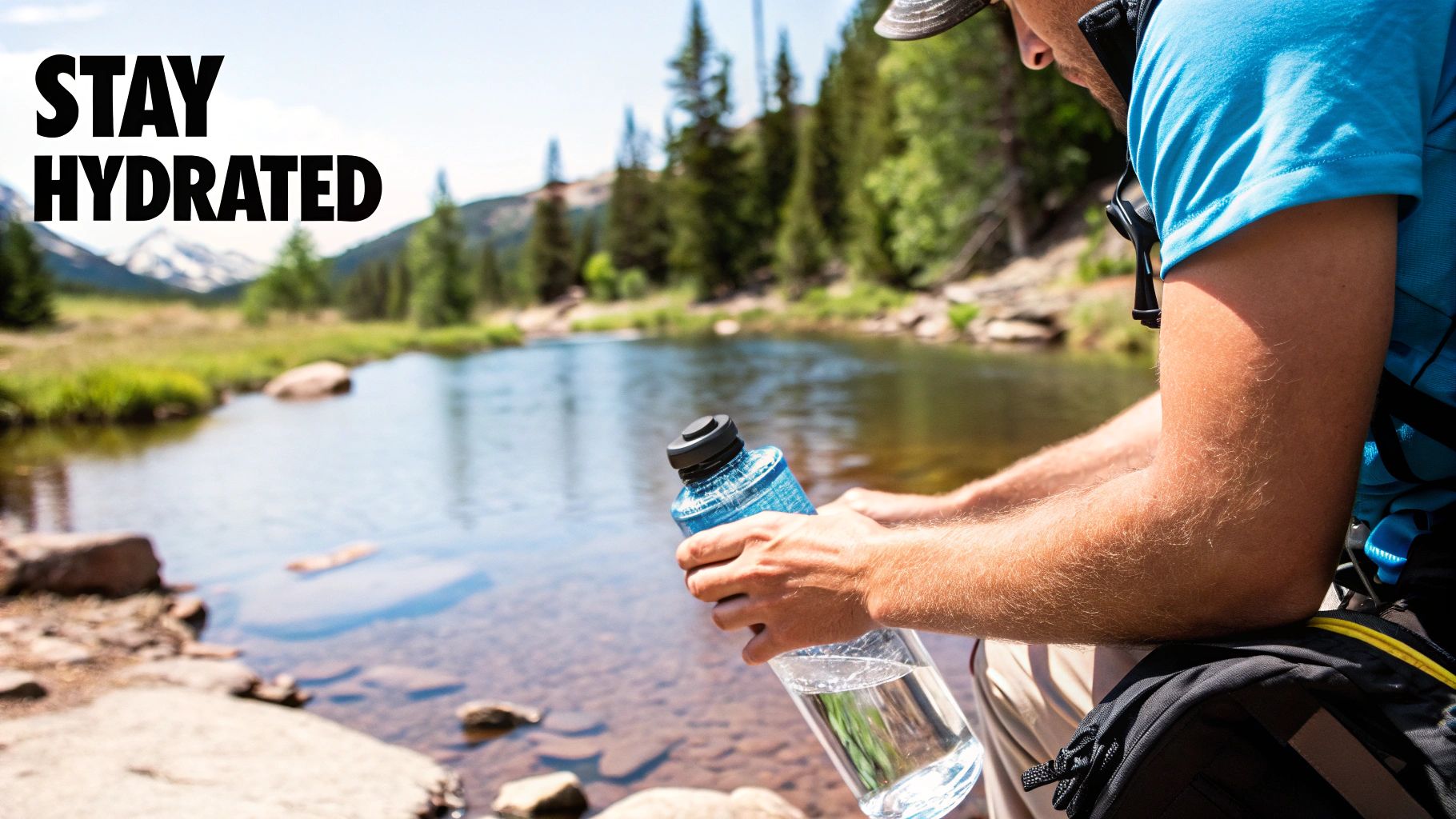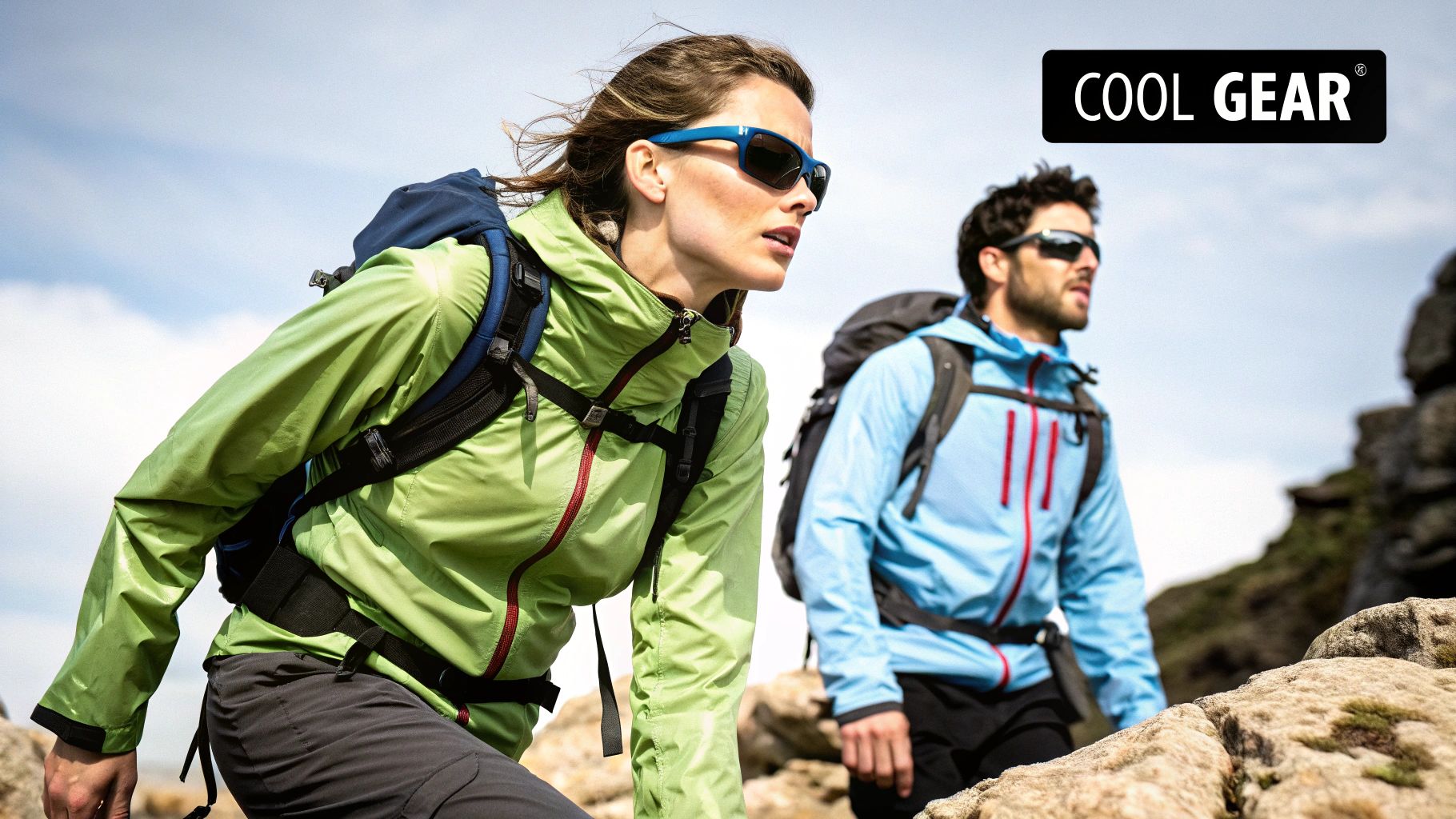With over 10,000 orders
With over 10,000 orders

Photo by Timmy Wesley on Unsplash
Understanding heatstroke and sun safety for long hikes isn't just a casual tip—it's a core survival skill. A beautiful day on an exposed trail can flip into a medical emergency in a heartbeat if you underestimate the sun's power and your own body's limits.
That perfect sunny day can be incredibly deceptive. It’s easy to head out thinking a little heat is just part of the adventure, but that mindset completely overlooks the serious risks involved. The hard truth is that heat-related emergencies are becoming more and more common—and tragically fatal—on popular trails across the country. Preparation isn't just an option anymore; it's the most critical piece of gear you can carry.
This guide is designed to shift your perspective from just being aware of the heat to being truly prepared for it. Heatstroke isn’t just about feeling a bit too warm. It’s a life-threatening medical emergency where your body’s internal cooling system completely shuts down. Getting that distinction is the first step toward real safety on the trail.
Failing to prepare can have devastating consequences. We've seen a heartbreaking surge in heatstroke-related deaths among hikers during recent extreme heat waves, particularly in the United States. In the summer of 2023, multiple fatalities were recorded in temperatures that shot past 110°F (43°C). Hikers in national parks from Big Bend to Death Valley were affected, with temperatures in Death Valley reaching a blistering 126°F. These recent hiking tragedies show just how quickly a situation can turn deadly.
The goal here isn't to scare you off the trails. It's to arm you with the knowledge you need to hike safely. A solid plan boils down to three key things:
Mastering these fundamentals means you can tackle those challenging hikes with confidence. For some quick strategies you can use right away, check out our guide on summer hiking tips to stay cool while hiking. This kind of prep work ensures your adventure is memorable for all the right reasons.
Your body is an incredibly smart machine, and it sends out clear signals when it’s starting to overheat on the trail. Learning to read these warnings is one of the most critical parts of sun safety for long hikes.
Think of it like a car engine. First, a warning light flashes on the dashboard. If you ignore it, smoke starts to appear from under the hood. Keep going, and eventually, the whole thing seizes up. Heat illness works in a very similar, predictable way. Catching the signs early in yourself or a hiking partner lets you take action before a small problem becomes a life-or-death emergency.
The very first signal your body sends is often heat cramps. These are sharp, involuntary muscle spasms, usually in your legs, arms, or stomach, that pop up during or after a tough, sweaty push.
They're a direct result of losing too much salt and fluid through sweat. If you start getting these, consider it your body’s first warning light. It's telling you that your electrolyte and fluid levels are getting dangerously low. This is your cue to stop, find some shade, rehydrate with an electrolyte drink, and gently stretch out the cramping muscle.
If you ignore the cramps and keep hiking, your body's cooling system starts to get overwhelmed. The next stage is heat exhaustion, and it's a much bigger deal. Your internal "engine" is now smoking, signaling that it can’t regulate its own temperature anymore.
The symptoms become more widespread. Knowing what to look for is the key to stopping a full-blown emergency in its tracks.
When you see these signs, it's time for immediate action. Stop all activity, get to the coolest spot you can find, sip water or an electrolyte solution, and loosen any tight clothing.
This infographic drives home the link between a dangerously high body temperature, the critical symptoms it triggers, and the immediate life-saving actions you need to take.

It clearly shows that once your core temperature climbs to 104°F (40°C) or higher, your central nervous system is in serious trouble, demanding an urgent response.
Heatstroke is a catastrophic failure of your body's thermostat. This is a true medical emergency that requires immediate professional help. The single biggest sign is a change in mental state; the person might become confused, disoriented, aggressive, or even lose consciousness. Their skin may become hot and dry to the touch as the body completely loses its ability to sweat.
The table below breaks down the key differences between heat exhaustion and heatstroke. Being able to tell them apart could save a life.
| Symptom | Heat Exhaustion (Warning Stage) | Heatstroke (Emergency Stage) |
|---|---|---|
| Body Temperature | Normal or slightly elevated | 104°F (40°C) or higher |
| Sweating | Heavy sweating | Little or no sweating; skin is hot and dry |
| Skin | Cool, pale, clammy | Flushed, red, and hot |
| Mental State | Dizziness, fatigue, headache | Confusion, disorientation, loss of consciousness |
| Pulse | Rapid and weak | Rapid and strong |
| Other Symptoms | Nausea, muscle cramps, faintness | Seizures, irrational behavior |
Recognizing that someone has crossed the line from exhaustion to stroke is the most important distinction you can make on the trail.
Heatstroke is not something you can "tough out." It can cause permanent disability or death if not treated immediately. The absolute first step is to call for emergency services while beginning cooling measures.

The absolute best way to handle a heat-related emergency on the trail is to make sure it never happens in the first place. Real heatstroke and sun safety for long hikes isn't about what you do when things go wrong; it starts with the choices you make long before your boots even touch the dirt.
Having a proactive mindset can transform a potentially dangerous situation into a manageable, even enjoyable, adventure. This goes way beyond a quick glance at the weather app. It means strategically planning your hike to work with the environment, not against it.
Think of this pre-hike checklist as your first and best line of defense against the sun.
Timing is absolutely everything when you're hiking in the heat. The sun is at its most brutal and dangerous between 10 a.m. and 4 p.m.—which, not coincidentally, is exactly when you should aim to be off exposed ridges and resting in the shade.
This kind of smart planning is becoming more critical than ever. Recent studies covering over 700 cities worldwide show a scary-fast increase in heat-related deaths during extreme summer weather, a direct fallout from rising global temperatures. This alarming trend makes proactive trail planning an essential survival skill. You can dig into the data in the detailed climate change research from Carbon Brief.
Your body needs time to get used to new climates. Jumping straight into a strenuous, multi-day hike in a hot, dry desert right after leaving a cool, humid region is a recipe for disaster. This crucial adjustment period is called acclimatization.
Acclimatization is the process where your body gradually gets better at cooling itself in a new climate. It can take anywhere from four to fourteen days for your body to fully adapt to higher temperatures.
During this window, your body learns to sweat more efficiently and hang onto its electrolytes. If you don't have two weeks to spare, at least start with shorter, less demanding hikes for the first few days. Give your body a fighting chance to catch up. Pushing too hard, too soon, is a surefire way to increase your risk of heat exhaustion and heatstroke.
Proper nutrition and hydration are completely non-negotiable. What you eat and drink before and during your hike directly impacts your body’s ability to keep its cool. And on demanding treks, just drinking plain water often isn't enough.
As you sweat, your body loses critical salts, or electrolytes. When you lose too much, you're setting yourself up for muscle cramps, dizziness, and other nasty symptoms of heat exhaustion. To fight this, you need to actively put those electrolytes back in.
By taking these steps before you even start, you build a strong foundation for safety. This ensures your focus stays on the beauty of the trail, not on a brewing emergency.

Let's get one thing straight: staying hydrated on a hot trail isn't about carrying the biggest water bottle you can find. To really get a handle on heatstroke and sun safety for long hikes, you need a solid game plan for managing your body’s fluid and fuel. This is a deliberate strategy that starts before you even tie your boots, continues with every sip on the trail, and finishes long after you've kicked them off.
Just chugging plain water for hours on end won't cut it. Think of your body as a high-performance engine; it needs both water for cooling and the right minerals to fire on all cylinders. Get that balance wrong, and the whole system starts to sputter.
When you're sweating buckets, you're losing more than just water. You're also flushing out essential minerals called electrolytes, and the big one you need to worry about is sodium. These minerals are the spark plugs for your muscles and nerves, keeping everything firing correctly. When you run low, you'll feel it—muscle cramps, dizziness, and that foggy-headed feeling are all classic signs of heat exhaustion setting in.
This is exactly why drinking only plain water can sometimes backfire. It dilutes the electrolytes you have left, which can actually speed up the onset of heat-related problems.
A classic rookie mistake is overhydrating with plain water while totally ignoring electrolytes. This can lead to a seriously dangerous condition called hyponatremia, where the sodium in your blood drops to critically low levels.
If you're serious about your endurance and want to avoid hitting a wall, it’s worth understanding metabolic flexibility for endurance performance and how your body uses different fuel sources.
A smart hydration plan is proactive, not reactive. If you're waiting until you feel thirsty to drink, you're already behind the curve and playing catch-up.
1. Pre-Hydrate Before the Hike
Your hike prep should start the day before. Drink plenty of water throughout the day, and consider having an electrolyte drink with dinner. Then, about one or two hours before you hit the trail, drink another 16-20 ounces (about 500-600 ml) of water or an electrolyte mix. This ensures your tank is full from the get-go.
2. Sip Consistently on the Trail
Don't wait until you're gasping for a drink. The goal is to sip small amounts, often. Aim for about half a liter to a full liter of fluid every hour, adjusting for the intensity of the heat and how hard you're working. A hydration reservoir with a hose is perfect for this, making it easy to take small, frequent sips without breaking your stride.
3. Fuel with Salty Snacks
You have to put back the salt you're sweating out. The easiest way to do that is by snacking on salty foods throughout your hike. It's a simple trick that makes a huge difference in keeping your electrolytes balanced. Some great trail-friendly options include:
Getting this balance between fluid and salt right is a total game-changer. For a much deeper dive into the science, check out our complete guide on how to prevent dehydration while hiking. A little planning here can turn what could be a punishing, miserable day into a successful adventure.

Your gear is so much more than just the stuff you lug around in your pack—it’s your first line of defense against the sun and a personal cooling system all in one. The right equipment actively shields you from UV rays and helps your body do what it does best: regulate its temperature. Real heatstroke and sun safety for long hikes starts long before you hit the trail; it starts with the gear you choose.
Think of your clothing as portable shade. That old cotton t-shirt might feel fine at the trailhead, but once you start sweating, it turns into a wet, clingy mess that traps heat right against your skin. This is exactly why seasoned hikers swear by synthetic, moisture-wicking fabrics. They pull sweat away from your body, letting it evaporate and cool you down naturally.
When you're shopping, keep an eye out for clothing with an Ultraviolet Protection Factor (UPF) rating. A UPF 50+ rating is the gold standard, blocking over 98% of the sun's harsh rays. For comparison, a plain white cotton shirt might only give you a UPF of 5. The difference is huge.
Even with the best sun-protective clothing, some skin is bound to be exposed. That's where sunscreen comes in. Whether you go for a mineral or chemical formula is mostly a personal choice, as both work great when you use them the right way.
Mineral sunscreens (like zinc oxide and titanium dioxide) sit on top of your skin and create a physical barrier. Chemical sunscreens work by absorbing UV radiation before it has a chance to do damage. If you have sensitive skin, mineral formulas are often a gentler option. The real key, though, is applying it consistently.
Reapplication is everything. Sweat and the friction from your pack straps can wear off your sunscreen in as little as an hour. Make it a habit to stop and reapply a generous amount every 60 to 90 minutes, hitting your face, neck, ears, and the backs of your hands. A little discipline here ensures your last line of defense never fails you.
When prevention fails and you're staring at a potential case of heatstroke on the trail, your next moves can literally be the difference between life and death. This isn't something a person can just "walk off" or fix with a quick rest. Heatstroke is a full-blown medical emergency, and recognizing that fact is the first critical step.
Your absolute number one priority is to call for emergency help. Whether you have cell service, a satellite messenger, or need to send another hiker for assistance, this must be your first move. While you're waiting for the professionals, your mission is simple: rapid, active cooling.
This is a serious global issue that's only getting worse. An estimated 489,000 deaths were linked to heat each year between 2000 and 2019. For adults over 65, the numbers are even starker, with mortality rates jumping by about 85% in recent years. You can dig into these worldwide heat and health trends from the World Health Organization to understand the scale of the problem.
While waiting for help to arrive, you need to act fast. Think of this as your life-saving checklist for heatstroke and sun safety for long hikes.
Crucial Do Nots: Never, ever try to give an altered or unconscious person anything to drink; they could easily choke. Also, don't give them fever-reducing meds like aspirin or acetaminophen. These won't help with heatstroke and could even make things worse.
Taking these immediate steps is absolutely vital. To build on these skills, it's a great idea to check out our guide on the fundamentals of wilderness first aid.
Even the most seasoned hiker has questions when the forecast calls for a scorcher. Planning is one thing, but knowing the "why" behind the rules is what really keeps you safe out there. Let's tackle some of the most common questions that pop up when you're getting ready to hit a hot trail.
The old rule of thumb is a good starting point: plan on carrying one liter of water for every two hours you expect to be hiking. But when the mercury climbs above 90°F (32°C), you need to get more aggressive. A better plan is to double that to at least one liter per hour.
Of course, that's just a baseline. Think about your own body—are you a heavy sweater? Consider the trail itself. Is it a brutal, exposed climb? All these things, plus the humidity, will change your needs. The best advice is always to pack more water than you think you’ll need. A hydration bladder is fantastic because it encourages you to sip constantly, but remember, plain water isn't the whole story. You've got to replace the salts you're sweating out with electrolytes.
You absolutely can, and this is a sneaky one that catches a lot of people off guard. Heatstroke isn't just about getting blasted by the sun; it's about your body losing its ability to cool down. High heat and, more importantly, high humidity are the real enemies here.
On a hot, muggy, overcast day, the air is already saturated with moisture. This means your sweat can't evaporate off your skin effectively. Since evaporation is your body's number one cooling system, this is a huge problem. Your core temperature can start climbing to dangerous levels, especially when you're working hard. Always, always check the heat index—it combines temperature and humidity to give you the real story of what it feels like out there.
On a hot day, you want snacks that do two jobs at once: deliver quick energy (carbohydrates) and replenish lost salts (electrolytes). Salty snacks are your best friend on the trail because they directly replace the sodium pouring out of you lose in sweat.
Your ideal hot-weather trail snack should be light, packed with electrolytes, and give you a quick energy boost without making your digestive system work overtime.
Some of my go-to options include:
Steer clear of heavy, fatty, or super high-protein meals. Your body has to divert a lot of energy and water to digest that stuff, which is the last thing you want when it's already maxed out trying to keep you cool.
At TREKOLOGY, we're all about designing lightweight, reliable gear that keeps you safe and comfortable on every adventure. Check out our innovative trekking poles and portable chairs to lighten your pack and make your next hike even better. Discover the difference at https://trekology.com.
{"one"=>"Select 2 or 3 items to compare", "other"=>"{{ count }} of 3 items selected"}
Leave a comment